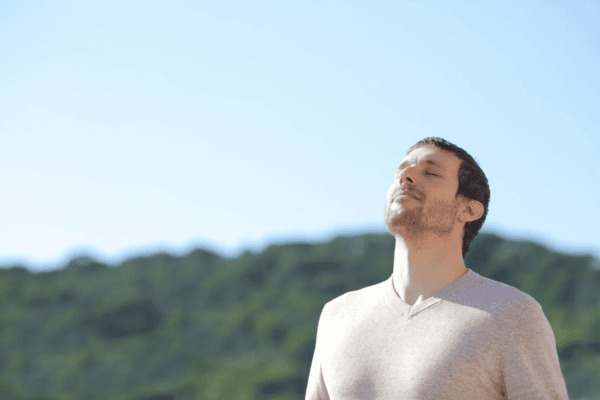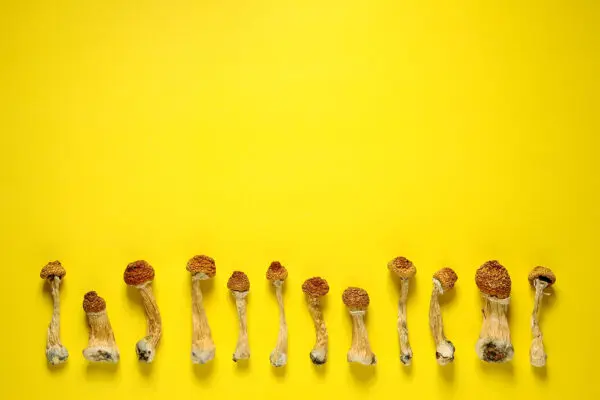Is Microdosing Mescaline Legal?
In this day and age, “microdosing” has become quite the buzzword — both within and beyond the world of psychedelics. Claimed by many to be an alternative to pharmaceuticals and a shortcut to productivity, microdosing is regarded by some as a miracle or a testament to the power of placebo, and by others as a cultish marketing scheme to avoid.
Everyone can agree on one thing: mescaline is still an illegal psychedelic drug. More specifically, it’s a Schedule 1 phenylethylamine, determined to have no medical benefit, and to be highly addictive — even though it is not. Mescaline has a low potency, but because mescaline is a Scheduled drug, there have not been any clinical trials in humans. And oftentimes, more potent mescaline derivatives turn up in the illicit drug supply.
Before the passage of the Controlled Substances Act, therapists used mescaline in research and therapy. And before that, mescaline even had a popular moment in Western culture and humanist philosophy. Peyote and San Pedro, the cacti mescaline is extracted from, are much older than all of this, and have been used in traditional ceremony and healing rituals from the Andes to the Great Plains (but we are only focusing on isolated mescaline in a European-American cultural context). You can learn more about those plant medicines here: A Beginner’s Guide to San Pedro and Why Peyote Sustainability Matters.
While mescaline in its biosynthesized state may be a safe psychedelic, one might be surprised to learn that many synthetic versions of mescaline can be hazardous and potentially lethal. As a result, when it comes to microdosing mescaline, there are some unique risks to be aware of for people who procure mescaline from unknown sources.
But before we dive in, we’ll review some background on the very first drug that inspired the term “psychedelic.” For a detailed dive into the macro history of mescaline, check out Mike Jay’s Mescaline: A Global History of the First Psychedelic.
Before Mescaline Was A Psychedelic
Mescaline was first isolated from a sample of the sacramental peyote cactus in 1896. It was the first psychedelic drug to be synthesized in 1919 by a German chemist named Arthur Heffter. During the early 20th century, mescaline rose to prominence in Europe, first in Germany, and later as a research chemical for psychedelic research studies in the United States and Canada. One prominent figure in these studies, psychiatrist Humphrey Osmond, shared mescaline with Aldous Huxley, who would later write about his experiences in several books. In poetic correspondence between the two men, Osmond coined the term “psychedelic” in 1957 when he wrote “to fathom hell or soar angelic, just take a pinch of psychedelic”.
Long before the infamous Al Hubbard distributed the CIAs supply of LSD to the masses, European philosophers thought that mescaline could be used for reflection and recreation. In 1898, Havelock Ellis, a professor of pharmacology at Heidelberg University published an article “Mescal: A New Artificial Paradise“. The article detailed his experience using mescaline cactus on Good Friday, a day he judged to be “fitting” for a personal experiment. Ellis went on to share the mescaline cacti with Y.B. Yeats of the Order of the Golden Dawn, an occultist organization led by Aleister Crowley that frequently used mescaline and was popular in Europe at the time. Ellis would go on to study sexuality, and pave the way for Freudian psychoanalysis — and early eugenics.
Ellis’s published essay would complement similar personal accounts of mescaline use, like one by S. Weir Mitchell published in The British Medical Journal. According to some, these men are considered the first “psychonauts” as defined by Ernst Junger, a term that means “sailor of the soul.” However, by removing the drug from the ceremony and culture of origin, this research established a precedent of extraction and exploitation that would come to define psychedelic research.
During the following years, while the Native Americans were being persecuted for peyote, mescaline was being regarded as an intellectual hallucinogen in Europe, acclaimed for its visions and ability to support progressive self-reflection. At the time, an educated doctor was assumed to have more evolved self-reflections and visions, while a layperson or laborer who used peyote traditionally was thought to lack the ability to think deeply about their life. Even in this earliest case of psychedelic drug use, there were inclinations of racism and classism that persist today.
Ellis’ trip report had a lasting impact, and before World War I a group of young philosophers and theologians were independently exploring the boundaries of mescaline while studying under existentialist philosopher Karl Jaspers at Heidelberg University. Jaspers was an advocate for the idea that people should create their own meaning in life, and these students took his advice with a dose of mescaline and lively debate. Unlike his contemporary Sigmund Freud who worked with repression and subconscious, Jaspers sought to help people build their personal meaning in life in pursuit of self-actualization, an idea that would later have a lasting impact on psychedelic culture in the United States.
It would seem that this group of scholars and philosophers recognized that mescaline could be an intense experience for heightening self-awareness and phenomenological thought and analysis. This Heidelberg school of thought would eventually influence the understanding that mescaline could be used for therapeutic purposes, such as psychotherapy. And perhaps, that altered states could lead to revolutionary thinking. Jaspers would eventually be removed from his teaching post as Heidelberg came under Nazi control. Mescaline research continued, but so too did unethical experimentation.
Mescaline Self-experimentation
Despite its overwhelming popularity, not everyone sang dogmatic praises of mescaline. In fact, in his 1929 essay “Surrealism: The Last Snapshot of the European Intelligentsia,” Walter Benjamin described these altered, mystical mind-states as an “introductory lesson” of “profane illumination,” suggesting that the insights of self-reflection were dangerous because they could counter one’s cultural framework, and thus, make it very difficult to go on living in society.
As the use of mescaline and the culture of inspired drug use made its way to Berlin, where psychiatry was beginning to take on a substantial role in medicine, the scientists who were studying mescaline became more interested in its effects on those suffering from mental illnesses. The idea that mescaline could be used to mimic psychosis in patients, a property known as psychotomimetic, was common at the time. The medical field began examining this idea more closely — including administering the drug to artists.
Julian Trevelyan, a surrealist painter, found mescaline inspiring, while another artist Basil Beaumont, experienced “excruciating pain and fear” when he self-experimented with mescaline. Well-known philosopher Jean-Paul Sartre experienced a painful hell during his mescaline trip, one that his sitter, acclaimed philosopher Simone de Beauvoir described as “torturous.” These accounts were all engaged willfully, but there is also mescaline research tied to nefarious scientists.
During World War II, the Nazis notoriously experimented on prisoners with drugs such as mescaline. Nazi physician Kurt Plötner dosed concentration-camp prisoners with mescaline at random to see whether it had any effect as a truth serum. Mescaline experiments were also performed in the United States under a secret program run by the CIA called MK-Ultra. Dr. Plötner was recruited by Robert Hyde, a psychiatrist who oversaw covert studies in Boston, to help the United States test experimental materials like LSD and mescaline on consensual — and unsuspecting patients and prisoners.
Following WWII, mescaline was used in psychedelic research and therapy studies in the 1950s. But, once mescaline was regulated through the Controlled Substances Act of 1970, clinical trials and research were prohibited aside from small-scale studies that investigated abuse potential — as opposed to the therapeutic use of mescaline in psychotherapy.
Toward the end of the 20th century, chemist Alexander Shulgin worked with mescaline as a base for many chemical compounds. “Sasha,” as he was often called, went on to publish and share his work with the public. His book PiHKAL: A Chemical Love Story contains instructions for synthesizing mescaline from various sources like San Pedro cacti found on Peru’s Andean mountains. Always writing detailed reports on the self-experiments he conducted with his wife Ann, Shulgin used mescaline as a base to create MDMA, a more popular psychedelic drug for therapy. The DEA would ultimately declare an emergency ban on MDMA, listing it as a schedule I substance in 1985.
Mescaline Microdosing Harm-Reduction
On its own, mescaline is probably one of the safest known psychedelics but is relatively rare to come by. Still, people do report microdosing with mescaline, both naturally occurring and synthetic.
Mescaline can be synthesized from several cacti species using various methods. The most common are mescaline hydrochloride and mescaline acetate. Keep in mind that these compounds have a different molecular weight, meaning the dosage will be different between the two. Also, remember that white crystalline powders can all look the same — even to a trained eye.
People who seek mescaline from illicit sources may accidentally encounter a potentially toxic synthetic. Contaminants might include caffeine pille, or could include cocaine, opiates, or psychoactive research chemicals. Community harm reduction organizations like Bunk Police, Pill Reports, and local harm reduction organizations consistently report and disseminate information on adulterants showing up in drug supplies. Through community outreach at the grassroots level, people who use drugs and public health officials leaders work together to improve health.
Fortunately — for now — drug testing kits are legal in most states, but testing kits might be considered drug paraphernalia in some circumstances (testing kits are illegal in Illinois). Regardless of the dose of mescaline (or ketamine, cocaine, MDMA, or any illicit drug one is using) people should be cautious of contaminants, should never use alone, and should always have naloxone on hand to reverse an overdose in the case of an opioid adulterant.
One side-effect of the drug war is a tendency for underground supplies to be contaminated with more dangerous drugs, such as fentanyl. In recent years, fentanyl and other toxic mescaline-based synthetics called NBOMEs (N-Benzylphenethylamine) have resulted in accidental overdoses. These synthetics share the same classification of drugs called phenethylamines, which may produce similar effects as mescaline, but carry a significantly higher risk of fatality. While these are rare events, they could be non-existent — if people had easy access to drug testing kits to verify the content of their substances.
And perhaps, for this reason, some people choose to microdose mescaline by drying and grinding up cacti like San Pedro. However, there are many additional alkaloids present in living specimens, so arriving at a precise microdose that is consistent is unlikely. Some people suggest extracting one’s own medicine through standardized methods may be less risky than using unknown substances purchased online.
A Short History of Microdosing
Microdosing has certainly gained popularity over recent years, but the efficacy of microdosing is still uncertain.
Microdosing is most often attributed to James Fadiman, author of The Psychedelic Explorer’s Guide. However, Fadiman was initially informed about the process by Robert Forte, a psychedelic researcher and former Director of The Hoffman Foundation. Forte learned about microdosing from his teacher, the well-known Swiss chemist and the first person to synthesize LSD, Albert Hoffman. Forte shared the idea with psychologist James Fadiman, who wrote about it in The Psychedelic Explorer’s Guide, which quickly gained interest by the public who liked the idea of mental health benefits without the psychedelic experience.
As inquiries began coming in and people began sharing their progress, Fadiman began conducting studies of the subjective effects of microdosing alongside his assistant Sophia Korb. These studies revealed that those who microdose report increased levels of focus, creativity, and energy.
More recently, a study was published comparing the placebo effect with microdosing and found that placebo doses had the same positive effects as the group that was given psychedelic microdoses. Another study found that some nerve growth proteins levels were increased in a microdose of LSD, suggesting that even at sub perceptible levels, some sort of neurological impact occurs when microdosing.
Ultimately, we have no idea whether microdosing works because of the drug itself or because of the human psyche’s receptiveness to suggestion and persuasion. While the controversy around microdosing continues, it seems that clinical research is the only way to determine whether this process is beneficial and to what extent.
Does Microdosing With Mescaline Work?
People who microdose mescaline sometimes follow the Fadiman protocol. A microdose is only 1/10th of a standard dose, and a standard dose of mescaline is 100-200 micrograms, meaning about 1-2 milligrams of mescaline is the target range.
With the Fadiman protocol, a microdose is taken every third day, beginning on Day 1, Day 4, Day 7, Day 10, etc. This is because the body naturally builds up a tolerance to mescaline. If the dose is not small enough — the goal is for a microdose to be sub-perceptible.
Many people find benefit in journaling during their microdose protocol, which should not last for more than a few months. Considering that there is no research on the long-term impact of microdosing, there is no reason to assume that long-term microdosing is safe, and most people limit an initial protocol to 30 days.
As a classical psychedelic, mescaline operates on the same serotonin receptors impacted by psilocybin and LSD. Knowing that psilocybin and LSD support neurogenesis, it can be suggested that mescaline does as well. If so, and if the serotonin receptors are activated even at a microdose level, there may be a neuropharmacological component to microdosing.
And yet, one self-blinding study suggests that the placebo effect is more likely to be the source of reported benefits of microdosing, but microdosing is definitely difficult to study in controlled settings given all of the possible factors involved. But controlling for things as variable as weather, hormonal shifts, not to mention the news cycle, means that marginal changes in well-being might be less beneficial to study than things like long-term relief from chronic symptoms. Perhaps if combined with additional efforts toward self-care rituals like proper rest, consistent meal times, adequate hydration and good exercise, microdosing with mescaline can lead to long-term wellness.








